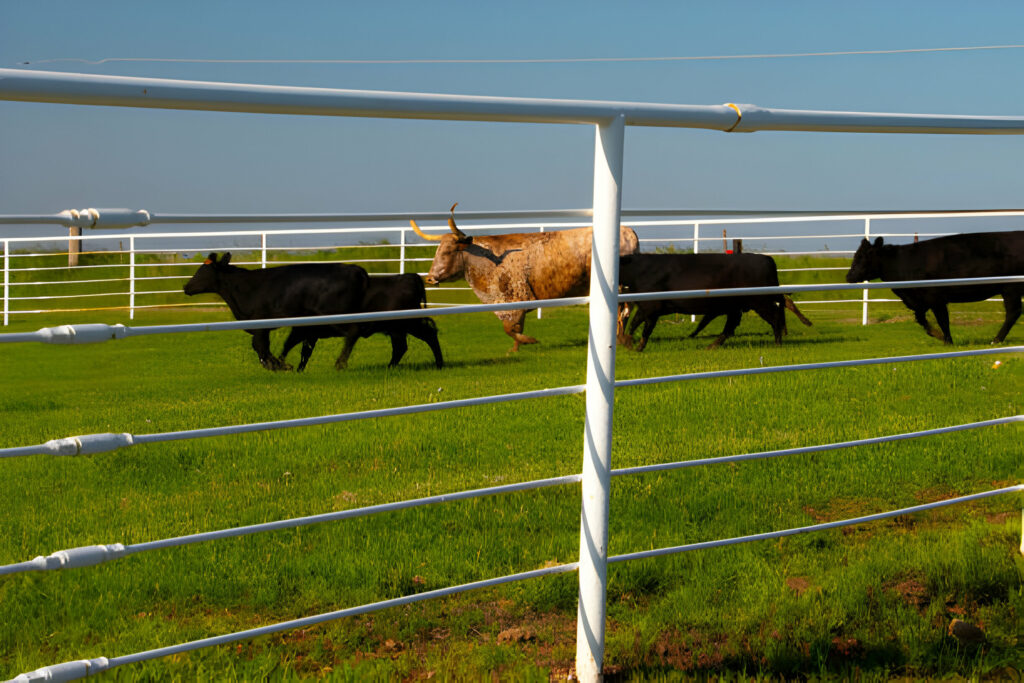
When it comes to investing in farm fencing for livestock containment, making sound choices matters tremendously. Opting for flimsy materials unable to withstand animal weight, chewing, digging, rubbing and other CSAs (that’s “Cow-Standard Abuse” for the city folks) almost always leads to headaches down the road. You want equipment that lasts.
That’s why we always recommend integrated Tensar Polygrid frameworks for perimeter boundaries and animal segregation. After installing high-tensile grid fencing on dairies, feedlots and ranches for over 35 years now, experience shows Polygrid tech simply outperforms all other options long-term.
In this post, I want to overview key considerations as you evaluate fencing needs on your land and explain why Polygrid is virtually unmatched for durability. My aim is to equip ranchers like yourself to determine ideal fence types for specific livestock containment scenarios. Let’s dig in!
Key Factors Influencing Fence Choice

While no universal recommendation exists across the board (stall divider panels need different attributes than back 40 acreage for rotational grazing), these elements play a major role:
1. Animal Type & Size
Cattle require intensely strong reinforcements up to 30,000 lb/ft tension capacity. Sheep and horses also necessitate fortified builds but less extreme. Goats? Well, let’s just say that old adage about them eating everything rings true! Match fencing height and strength appropriately.
2. Acreage Size & Layout
Greater expanses call for permanent perimeter fencing like high tensiles. Internal divisions for paddocks rotation may use more flexible step-in posts. Cost also determines options for larger ranchers. Layout irregularities like ditches, hills, and existing landscaping also influence plans.
3. Predator Pressure
Coydogs, wolves, and other threats in certain regions make sheep especially vulnerable without protective barriers. Fencing integrations like low-voltage electric strands along tensioned wire take predator deterrence seriously. No room for half-measures against persistent predators.
Snow-prone northern turf needs structures able to withstand substantial drift buildup without buckling. Coastal humidity and salt spray necessitate corrosion-resistant posts and wire. Extreme winds? That’s where rigid interlocking Polygrid excels at preventing collapse. Climate realities matter!
5. Budget Parameters
Fencing represents major investment on acreages of all sizes. Determining spacing between reinforced posts, evaluating electric fencing integrations, choosing premium longevity over bargain temp fencing—it all boils down to budget. Prioritize essentials first when funds limit options.
Now that we’ve covered major elements influencing farm fencing selection, let’s discuss…
Why Polygrid Tops for Durability

Alright, cutting to the chase: Polygrid frameworks simply last longer and require far less maintenance than any conventional livestock fencing alternatives. Its integrated grid construction prevents the host of issues woven wire and barbed wire eventually surrender to after weathering and animal punishment.
Stays Taut, Resists Sag
Polygrid’s exceptional tensile strength withstands 30,000 lb/ft pressure without stretching. Compare that to basic 12-gauge woven wire’s ~1,800 lb capacity before sagging. Once standard wire slackens, visibility and containment rapidly decline. It also signals structural issues. But Polygrid’s rigid triangular or rectangular interlocking design barely budges!
Withstands Most Impact Forces
Cattle rubbing, horses kicking, ranch equipment banging—Polygrid handles incidental collisions without compromise. The frames retain shape, keeping animals safely enclosed. Polygrid’s sheer resilient strength brings peace of mind that temporary wire just can’t match.
Minimizes Corrosion & Rust
Premium steel alloy composition gives Polygrid fences up to triple galvanization protection from elemental exposure. Without oxidizing impurities, corrosion from wind, rain, or sun remains minimal compared to basic galvanized steel wire. That fortification saves you cost in premature replacement.
Discourages Burrowing/Escape Attempts
Some goat farmers swear their wily animals possess almost supernatural escape abilities. But Polygrid’s impenetrably sturdy subsurface construction foils digging escape plots in their tracks. Interlocked grids prevent soil erosion too. Tunnels won’t undermine fortified boundaries.
Simplifies Repairs
In those rare instances where damage does occur, Polygrid’s modular grid design empowers easy snap-in fixes. Just reconnect with built-in channel guides rather than restringing entire fence lines. Farm repairs don’t get more convenient than that!
Well I don’t know about y’all, but from where I stand, the facts speak for themselves. Polygrid consistently comes out on top against limitations woven or barbed wire battle after brutal winters, rowdy livestock seasons, and punishing Midwest thunderstorms.
Ready to Fortify Fencing on Your Farm?
If your current fences struggle with keeping assets safely contained over the long haul, let’s talk Polygrid upgrades tailored to your land. Or maybe you’re developing new pastures for rotational grazing and want to start smart, maximizing longevity. Either way, I know we can equip your operation to thrive for decades while saving major headaches down the road.
Reach out now for personalized recommendations and free price quoting. Let’s reinforce those boundaries and give you peace of mind that livestock (and equipment) stay put—this year, next year, and for years to come. Your farm future starts now; let’s build it right together!